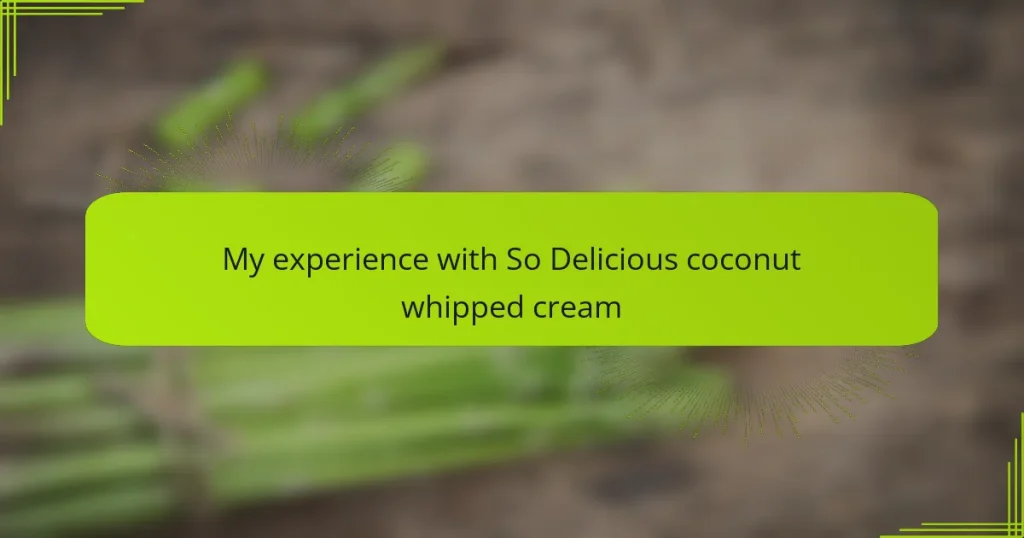Key takeaways
- Coconut whipped cream is a light, dairy-free alternative that enhances desserts with its tropical sweetness and creamy texture.
- It is versatile and accommodates various dietary needs, making it a joy to use in inclusive baking.
- Proper storage and serving of coconut whipped cream are essential for maintaining its fluffy texture and preventing separation.
- Simple recipes, like berry parfaits and no-bake desserts, showcase the delightful pairing of coconut whipped cream with fresh ingredients.
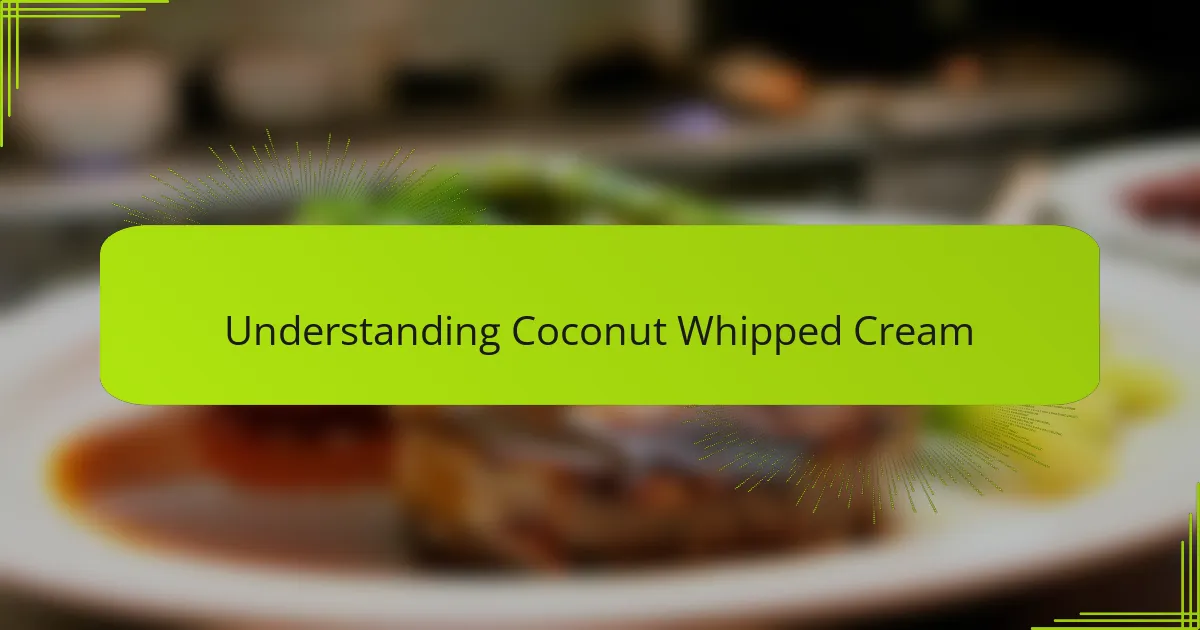
Understanding Coconut Whipped Cream
When I first encountered coconut whipped cream, I was curious about how it differed from the traditional dairy version I grew up loving. What surprised me most was its light, airy texture that somehow manages to feel both indulgent and refreshing at the same time. Is it possible to enjoy something so creamy without the heaviness of regular whipped cream? From my experience, coconut whipped cream answers that question beautifully.
The magic behind coconut whipped cream lies in its main ingredient—the natural cream from coconut milk. Unlike dairy, this plant-based alternative brings a subtle, tropical sweetness that adds a unique dimension to desserts. I’ve found that understanding this really changes how I approach recipes, especially when I want a lighter finish that still packs flavor.
What struck me emotionally was how coconut whipped cream could magically transform a simple slice of pie into something special. It’s creamy yet delicate, and that balance makes me appreciate how versatile it can be. Have you ever wondered how something so simple can evoke such warm feelings? For me, it’s about the comfort and freshness that coconut whipped cream brings to the table.
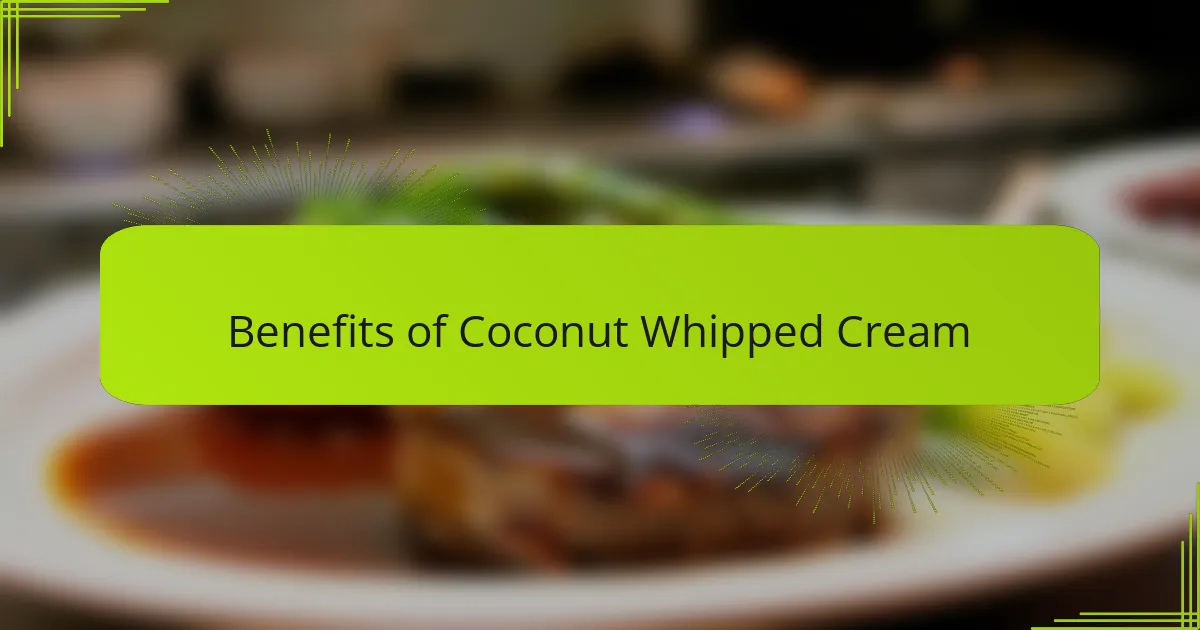
Benefits of Coconut Whipped Cream
One of the benefits I appreciate most about coconut whipped cream is that it’s naturally dairy-free. This made a big difference for me, especially when I wanted a luscious topping without the heaviness or stomach discomfort I sometimes get from traditional cream. Have you ever wished for a dessert that feels light but still indulgent? Coconut whipped cream delivers just that.
Another standout benefit is its subtle sweetness and tropical hint, which lifts the flavor profile of any dessert without overpowering it. I remember adding a dollop to a simple fruit tart and being pleasantly surprised how it enhanced the overall experience, almost like a mini vacation in every bite. It’s these little moments that remind me why I keep coming back to this alternative.
Lastly, I’ve found coconut whipped cream to be quite versatile and easy to work with, especially when catering to different dietary needs. Whether it’s vegan, gluten-free, or simply a preference for plant-based options, I feel confident using it in recipes that satisfy everyone at the table. Doesn’t it feel good to have a dessert ingredient that everyone can enjoy without compromise? For me, that inclusivity adds a lot of joy to baking and sharing treats.
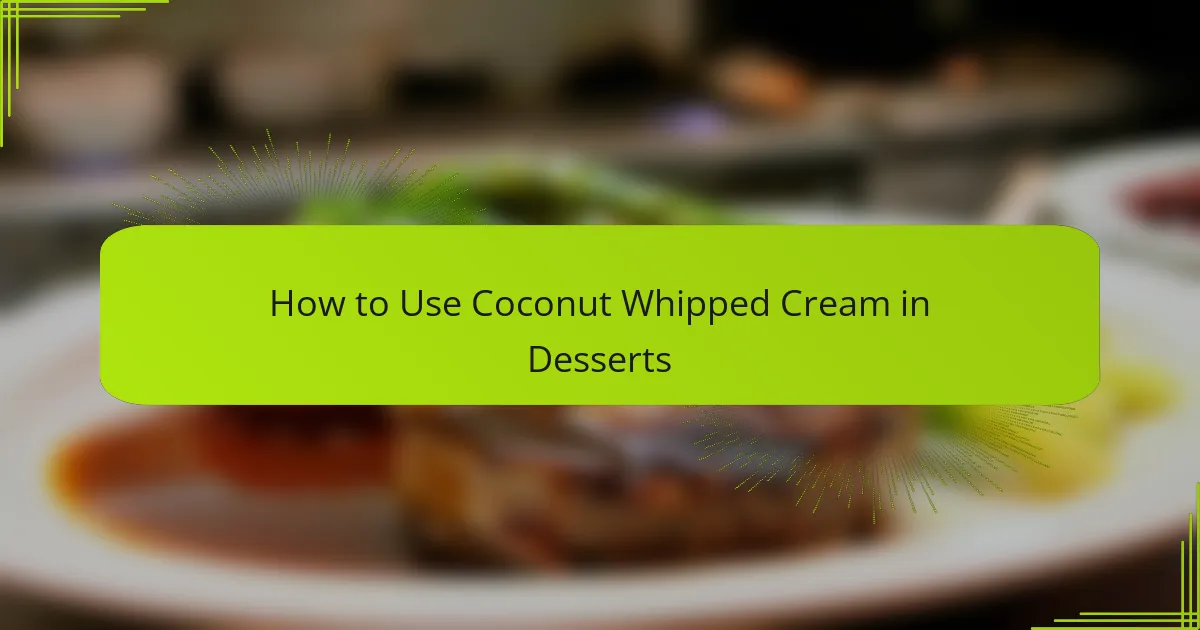
How to Use Coconut Whipped Cream in Desserts
Using coconut whipped cream in desserts has become one of my favorite ways to add that extra touch of creaminess without overwhelming the palate. I often spoon it over warm berry cobblers or pumpkin pies, where its light tropical flavor brings out the best in each bite. Have you ever noticed how a simple dollop can elevate a dessert from ordinary to memorable?
Sometimes, I like to swirl coconut whipped cream into mousse or pudding for a subtle creaminess that feels indulgent yet not too heavy. It’s fascinating how easily it blends, creating that smooth texture I love without any dairy aftertaste. This versatility makes me reach for it whenever I want to impress guests with a plant-based twist.
For those who enjoy fruit-based desserts, coconut whipped cream is a dream partner. Sprinkling it over fresh mango slices or a bowl of mixed berries instantly adds a refreshing contrast. Doesn’t it feel satisfying to use something so natural that also enhances the dessert’s vibrant flavors? In my experience, this simple addition always sparks smiles around the table.

My Experience with So Delicious Coconut Whipped Cream
Using So Delicious Coconut Whipped Cream felt like discovering a hidden gem in my kitchen. The first time I tried it, I was impressed by how effortlessly it whipped up into cloud-like softness, with a sweet, coconutty aroma that immediately lifted my spirits. Have you ever tasted something that’s both comforting and exciting at the same time? That’s exactly how this whipped cream made me feel.
What really struck me was how well it held its shape on top of my favorite desserts. Unlike some dairy-free toppings I’ve tried, So Delicious stayed fluffy and didn’t melt away too quickly, which made serving and enjoying desserts less stressful. I remember my family’s delighted reactions, especially when they found out it wasn’t traditional cream—it felt like a little win for both taste and health.
And here’s something I didn’t expect: it sparked creativity in my dessert making. I began experimenting, adding it not just as a topping, but folding it into batters and mousses for extra richness without heaviness. Have you found a product that makes you excited to experiment? For me, So Delicious Coconut Whipped Cream opened a new door to enjoying desserts without compromise.
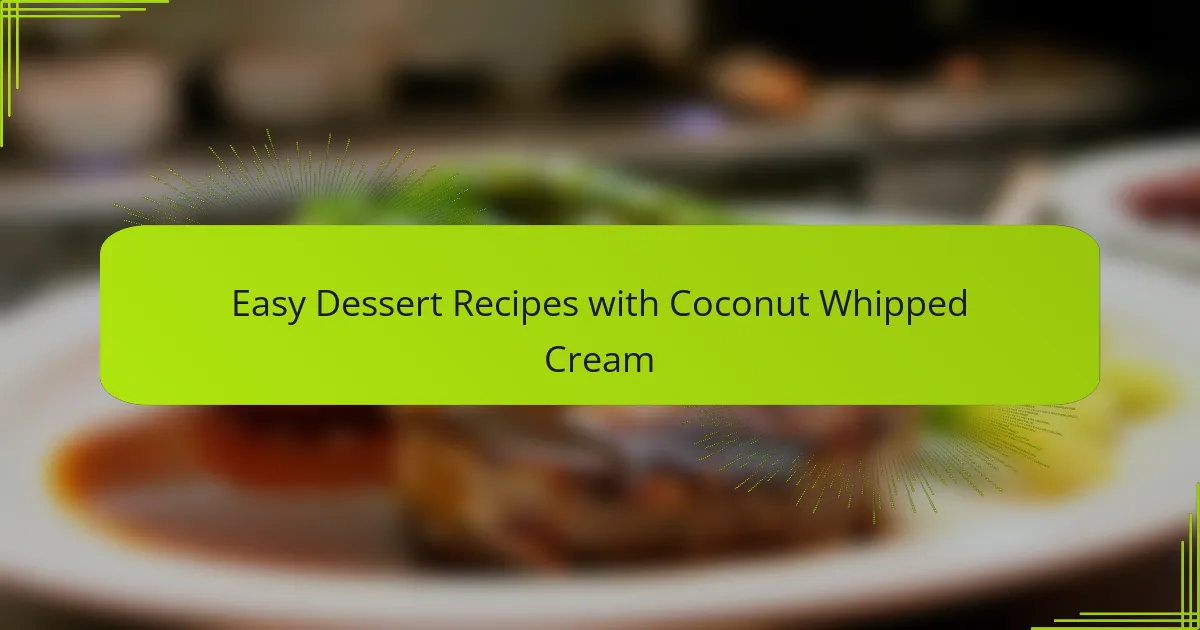
Easy Dessert Recipes with Coconut Whipped Cream
When it comes to easy dessert recipes with coconut whipped cream, I’ve found that simplicity brings out the best flavors. One of my go-to treats is a quick berry parfait—just layers of fresh berries, a drizzle of honey, and a generous scoop of coconut whipped cream. Have you ever noticed how a few ingredients can come together to feel so indulgent yet light? This combo never fails to satisfy my sweet cravings without any fuss.
I also love how versatile coconut whipped cream is in no-bake desserts. For example, mixing it with whipped chocolate ganache creates a luscious mousse that feels decadent but isn’t heavy. From my kitchen to yours, these kinds of recipes are a lifesaver when I want something impressive but don’t want to spend hours baking or cleaning up. It’s amazing how just adding coconut whipped cream can elevate the whole experience.
Another simple joy I’ve discovered is topping warm fruit crisps with a swirl of this creamy delight. The contrast between the warm, cozy fruit and the cool, airy coconut cream creates such a comforting balance. Don’t you think the best desserts are the ones that bring both comfort and a touch of freshness? This easy pairing always brings a smile to my face and makes dessert feel like a small celebration.
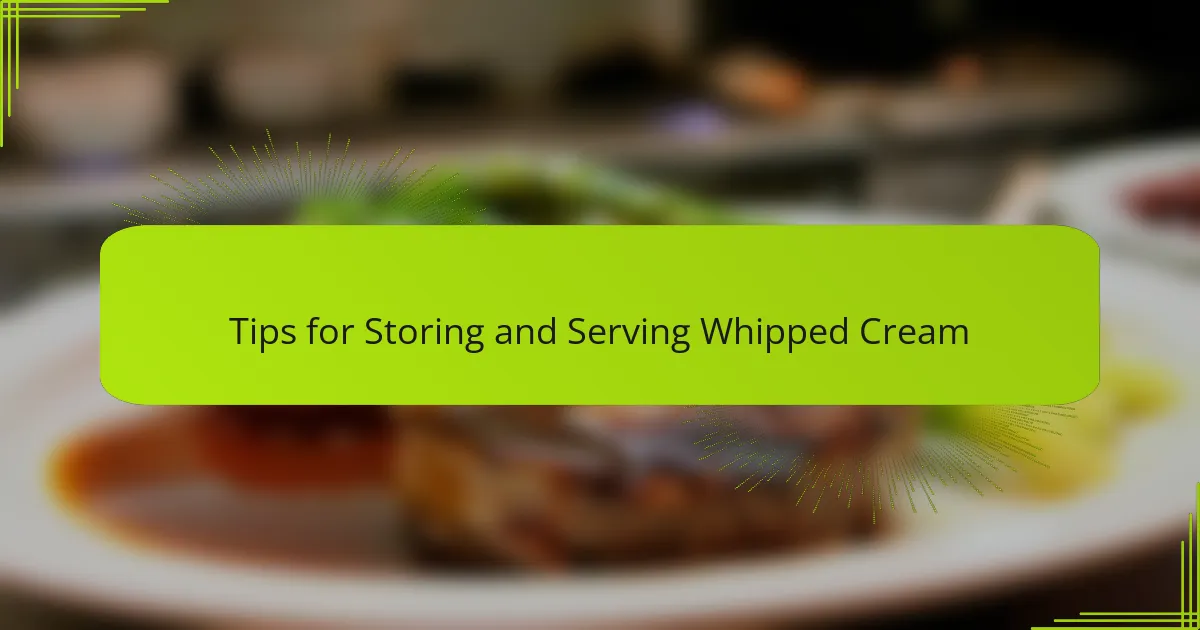
Tips for Storing and Serving Whipped Cream
One thing I’ve learned is that storing coconut whipped cream properly really makes a difference. Keeping it in an airtight container in the fridge helps maintain its fluffy texture and fresh coconut aroma. Have you ever opened a container only to find your whipped cream watery or separated? I certainly have, and it’s not pleasant—so sealing it tightly is key.
When it comes to serving, I like to give the can or container a gentle shake before using to revive that cloud-like softness. Sometimes, a quick whisk can work wonders if the whipped cream has started to settle. Do you remember how it feels to dollop perfectly whipped cream on your dessert? That little moment of fluffiness is worth a tiny bit of extra care.
Also, I’ve discovered that coconut whipped cream performs best when served cold but not ice-cold. If it’s too chilled, it can become a bit firm and harder to spread, which can be frustrating when you’re aiming for that smooth finish. For me, letting it sit at room temperature for just a few minutes before serving makes all the difference. Have you tried this little trick? It’s a simple step that changes the whole experience.

Troubleshooting Common Whipped Cream Issues
One thing I quickly realized is that coconut whipped cream can sometimes be a bit tricky to get just right. Have you ever mixed it and ended up with a runny or overly stiff texture? From my experience, it usually comes down to temperature—keeping the coconut milk chilled beforehand makes all the difference in achieving that perfect fluff.
Another issue I’ve bumped into is separation, where the cream and liquid parts split apart. It’s frustrating when you’re ready to top your dessert and the cream looks watery. What helped me was using the solid coconut cream from the top of the can, and giving it a good, gentle whisk. That little extra effort brought the cream back to life and saved the day more than once.
Sometimes, even the best coconut whipped cream flattens too quickly once it’s out in the open. Have you noticed it loses its shape faster than dairy cream? I noticed keeping it cool on the serving plate and spooning it out just before eating extends its lovely texture. It’s a small trick, but it made me appreciate how patient coconut whipped cream needs a little mindful handling.
